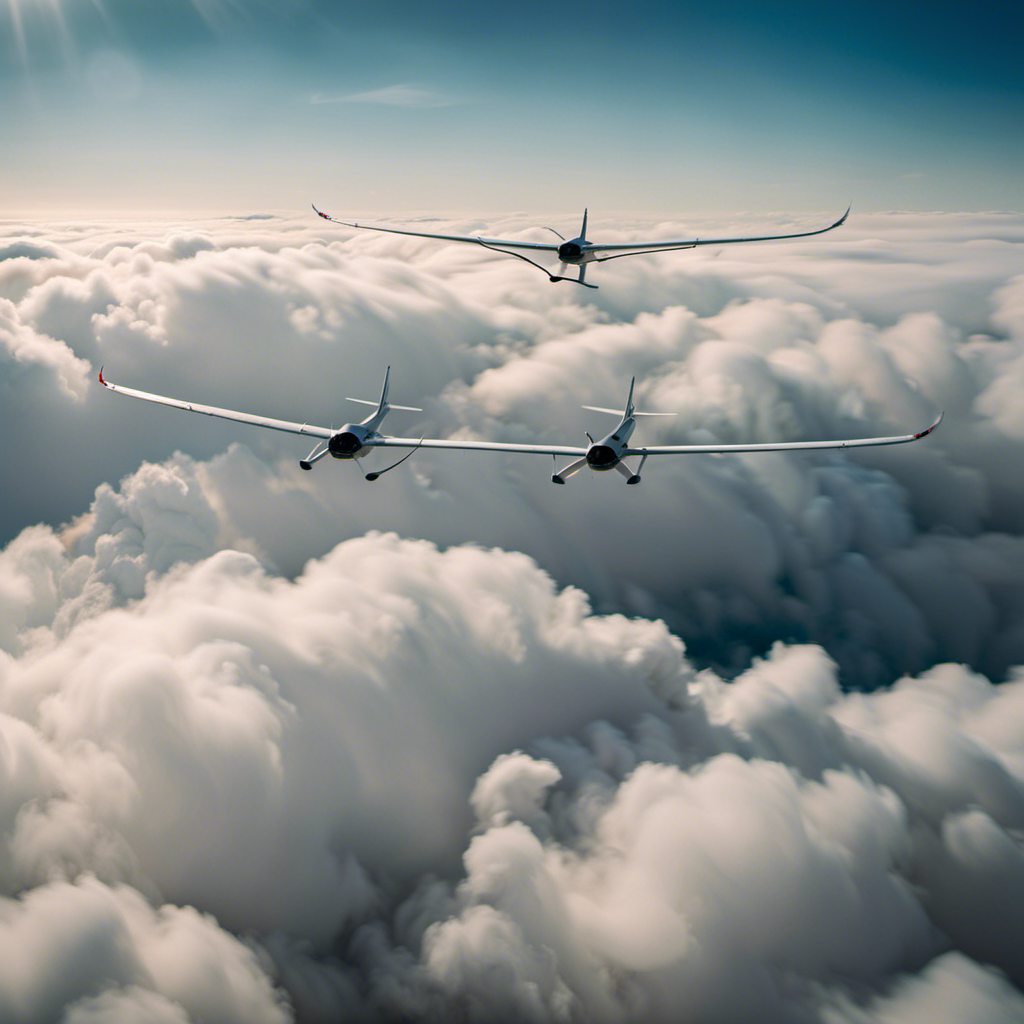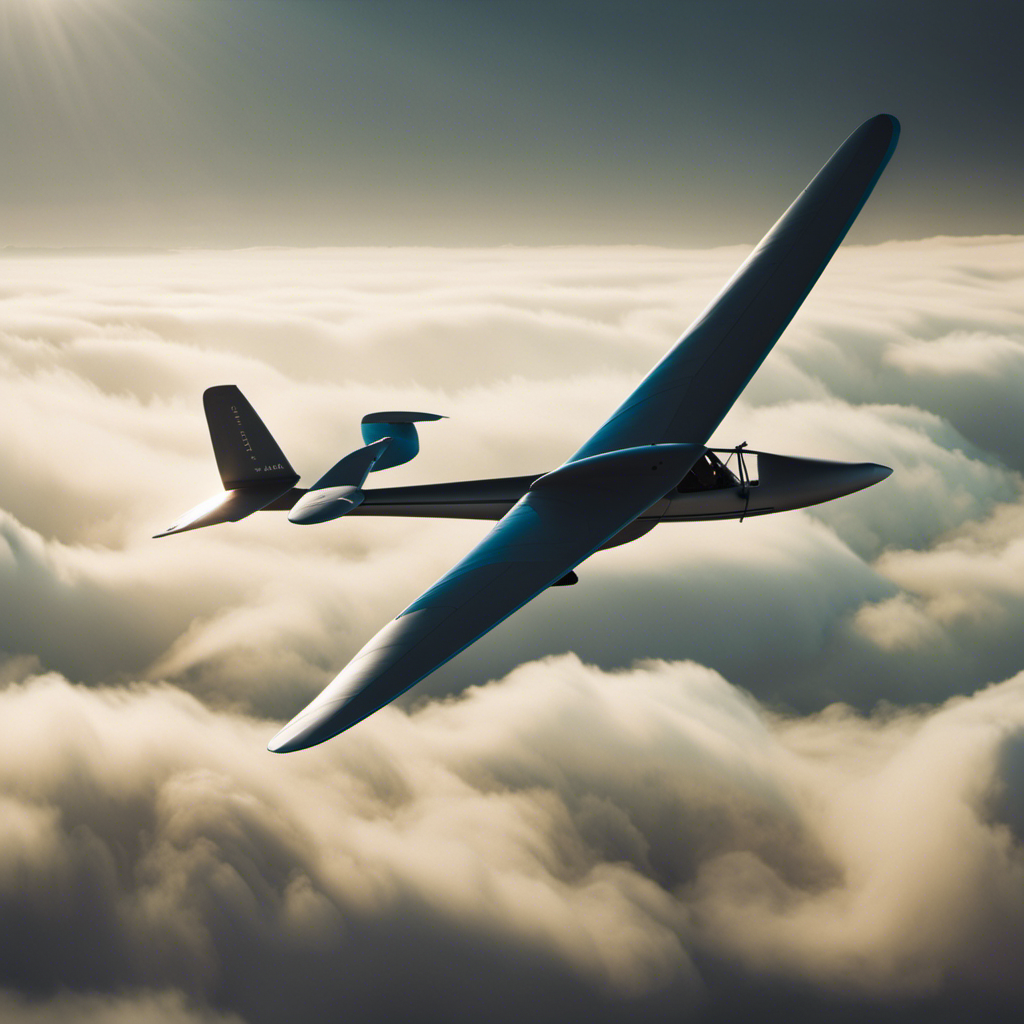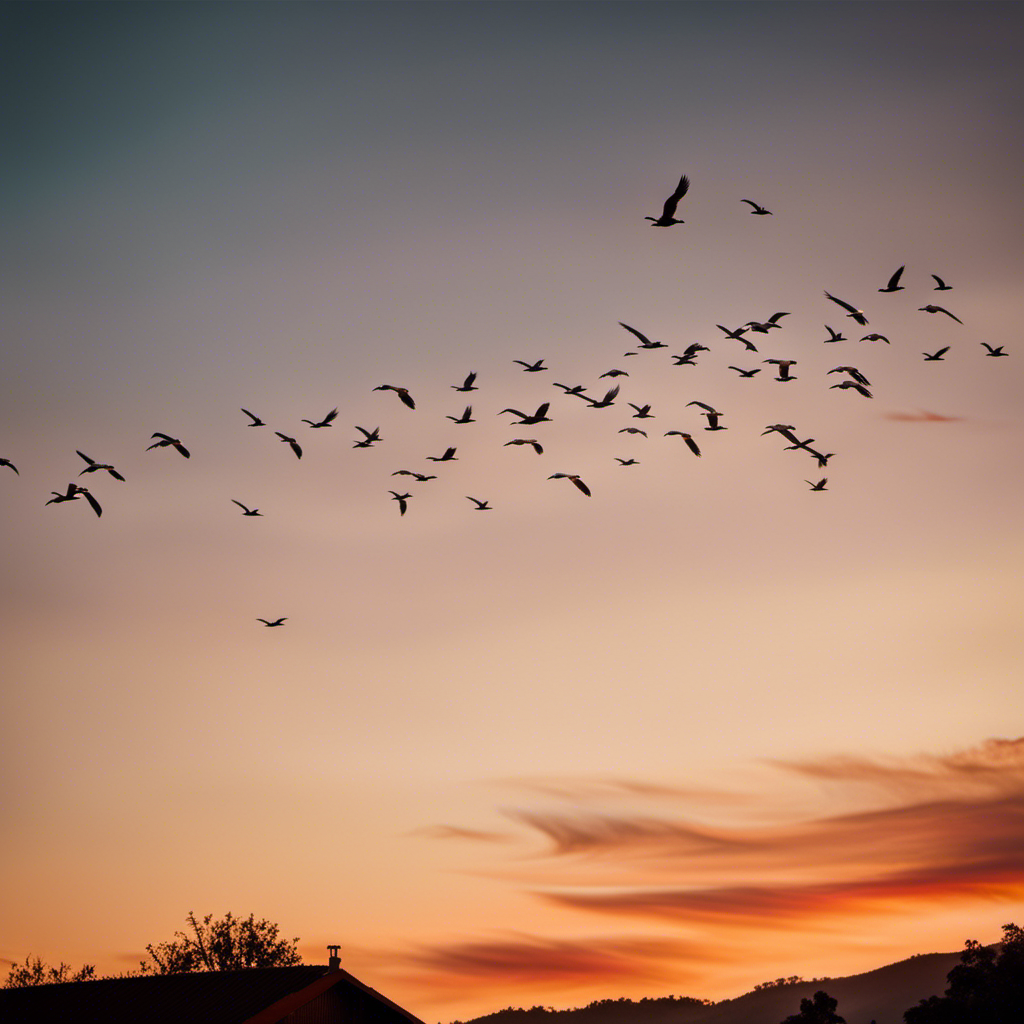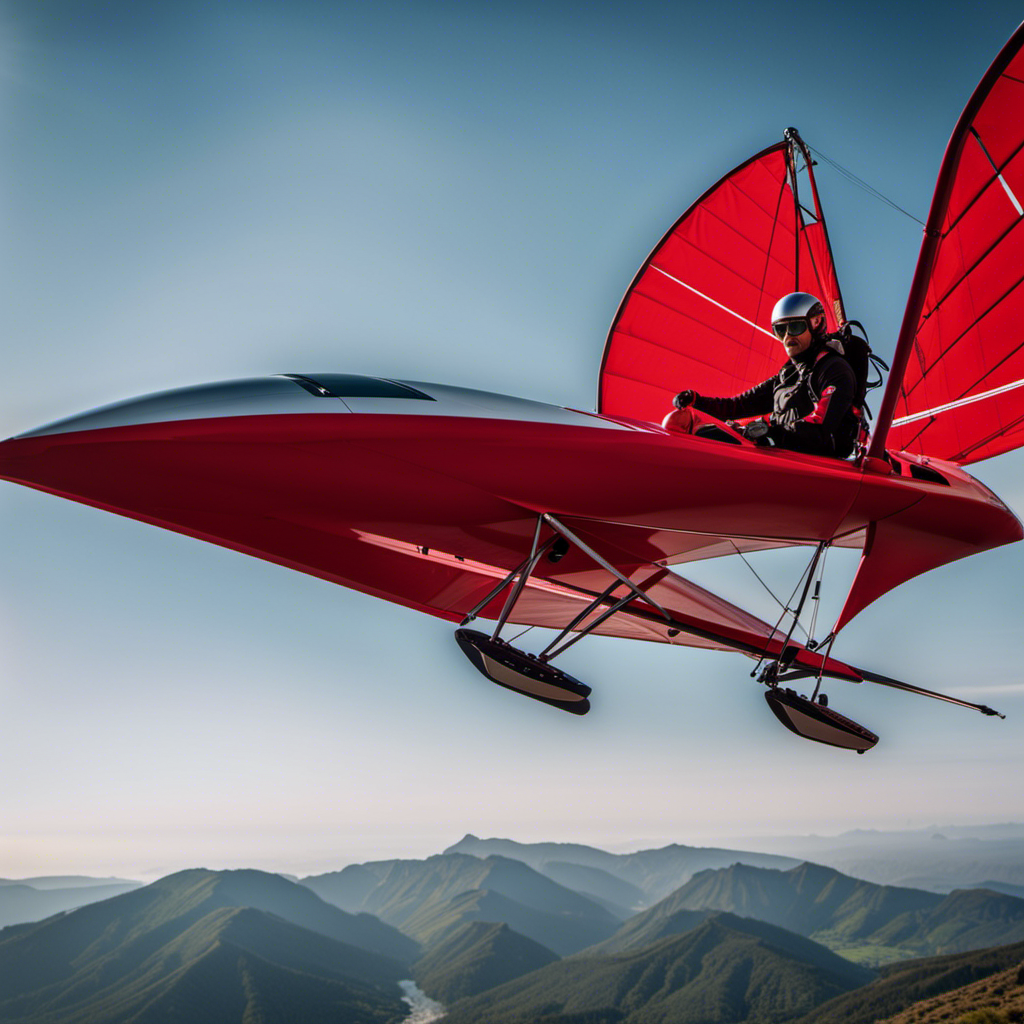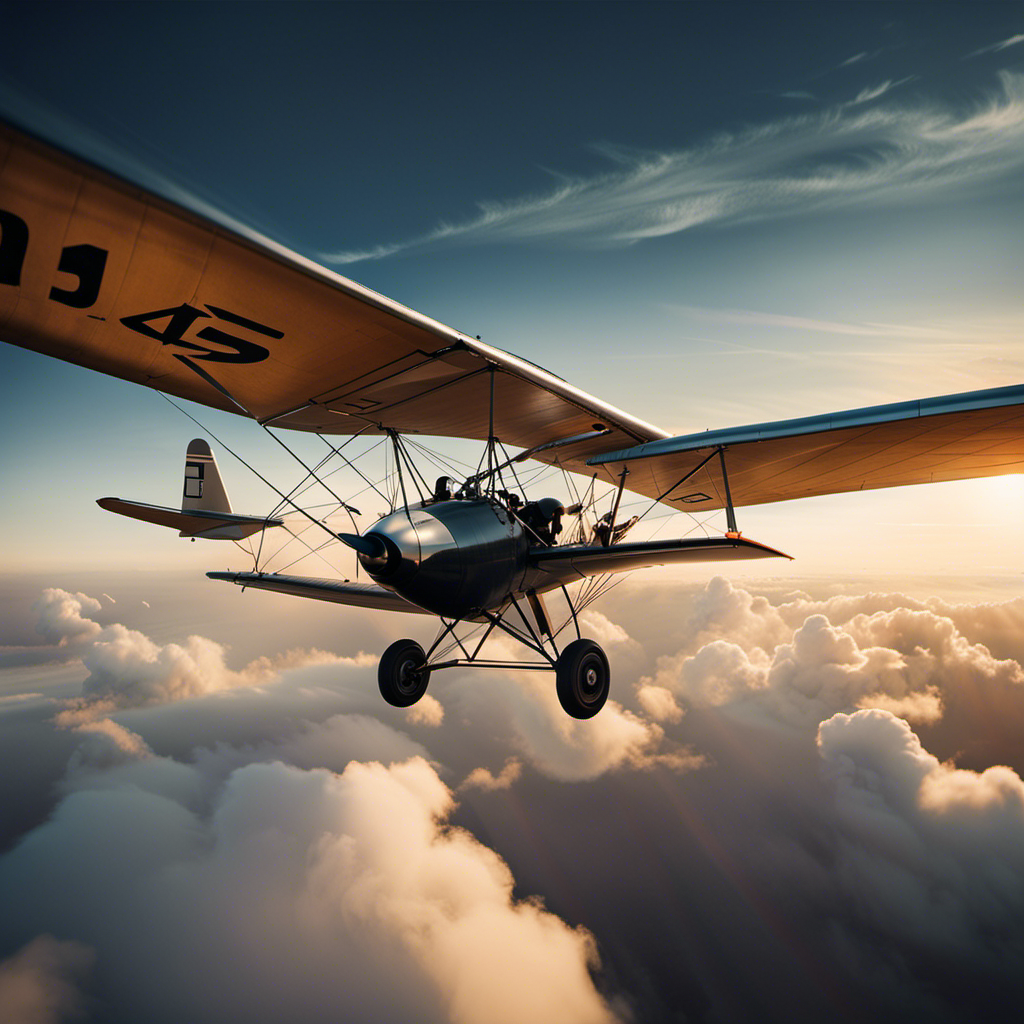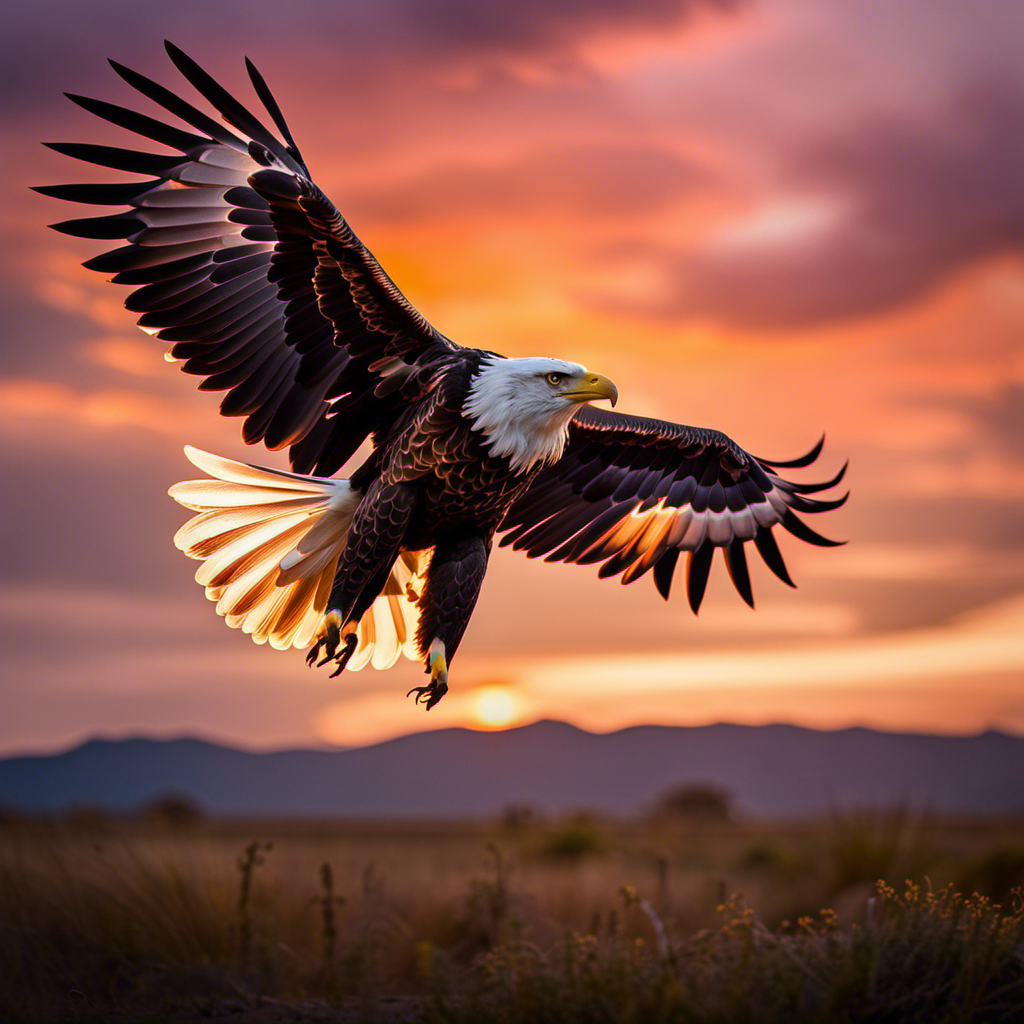You may think that mastering glider flight maneuvers is daunting, but I can assure you that it is entirely possible for you to achieve.
In this article, I’ll share expert tips on how to navigate turns and banked turns with finesse, recover from stalls like a pro, handle crosswinds with ease, and even perform thrilling loops and rolls.
We’ll also cover emergency procedures, soaring techniques, and advanced aerobatic maneuvers.
So buckle up, because we’re about to take your gliding skills to new heights.
Key Takeaways
- Pilots must understand lift and drag for maneuvers like turns.
- Maintain proper bank angle for efficient turns.
- Roll smoothly into the desired bank angle.
- Coordinate rudder input to counteract adverse yaw.
Understanding Lift and Drag Forces
To understand lift and drag forces, you’ll need to grasp the basic principles of aerodynamics. Lift and drag analysis is crucial in the field of aviation as it helps us understand the forces acting on an aircraft during flight.
In aerodynamics, lift is the force that opposes gravity and keeps the aircraft in the air. It is generated by the difference in air pressure between the upper and lower surfaces of the wings. The shape of the wings, known as the airfoil, plays a significant role in determining the amount of lift produced.
On the other hand, drag is the resistance that opposes the forward motion of the aircraft. It is caused by the interaction between the aircraft and the surrounding air.
By analyzing lift and drag forces, we can optimize the design of aircraft to achieve better performance and efficiency. Understanding the aerodynamics principles behind lift and drag is essential for pilots to master maneuvers such as turns and banked turns, as these maneuvers heavily rely on the manipulation of lift and drag forces.
Mastering Turns and Banked Turns
When turning the glider, it’s important to maintain a proper bank angle. Banked turns techniques are essential for maximizing turn rate and ensuring efficiency in flight.
To achieve this, begin by smoothly rolling the glider into the desired bank angle using aileron input. As the turn progresses, maintain a constant bank angle by coordinating rudder input to counteract adverse yaw. This will help maintain a balanced turn and prevent the glider from slipping or skidding.
Additionally, it’s crucial to manage the airspeed during the turn. By slightly increasing the back pressure on the control stick, you can maintain a consistent airspeed and prevent any loss of altitude. Furthermore, maintaining a coordinated turn by keeping the ball centered on the turn coordinator will ensure optimal performance.
Finally, it’s important to remember that while maximizing turn rate is essential, it should not compromise safety. Always prioritize maintaining control and situational awareness throughout the maneuver.
Perfecting the Stall Recovery
Remember, maintaining control and situational awareness is crucial when perfecting the stall recovery in your glider. The stall recovery is a critical maneuver that every glider pilot must master. A stall occurs when the wing exceeds its critical angle of attack, resulting in a loss of lift and a sudden drop in altitude. To prevent stalls, it is essential to employ proper stall prevention techniques, such as maintaining a safe airspeed and avoiding abrupt control inputs.
In the event of a stall, quick and correct action is necessary for a successful recovery. The recovery procedure involves reducing the angle of attack, increasing airspeed, and regaining control of the glider. It is important to note that recovering from a spin is a more complex situation and requires additional steps. Here is a table summarizing the steps for both stall recovery and spin recovery:
| Stall Recovery | Spin Recovery | |
|---|---|---|
| Step 1 | Reduce angle of attack | Reduce throttle and neutralize controls |
| Step 2 | Apply forward elevator pressure | Apply opposite rudder and aileron inputs |
| Step 3 | Increase airspeed by lowering the nose | Apply recovery technique specific to the spin |
Mastering the stall recovery and spin recovery techniques will greatly enhance your safety and confidence as a glider pilot. With these skills in your arsenal, you will be better equipped to handle unexpected situations while flying. Now, let’s move on to the next topic: navigating crosswinds.
Navigating Crosswinds
Navigating crosswinds can be challenging, but with proper techniques and practice, pilots can safely handle these conditions. One key aspect to master is crosswind compensation, which involves using aileron and rudder inputs to counteract the drift caused by the crosswind. As I approach the runway, I establish a crab angle, aligning the nose of the glider with the runway heading.
As I near touchdown, I start to kick the rudder in the direction opposite to the crosswind, known as the sideslip technique. This helps keep the glider on the centerline of the runway. Simultaneously, I apply aileron inputs to keep the wings level and prevent the glider from drifting off course. By smoothly transitioning from the crab angle to the sideslip technique, I can ensure a safe and controlled crosswind landing.
Now, let’s transition to performing loops and rolls, two exhilarating maneuvers that require precision and skill.
Performing Loops and Rolls
As a glider pilot, it is essential to understand the physics behind loops and rolls in order to execute these maneuvers safely.
Loops involve using the elevator to generate positive g-forces. This results in an upward and then downward curved flight path.
Rolls, on the other hand, require coordinated aileron and elevator inputs. These inputs are necessary to perform a complete rotation around the longitudinal axis of the aircraft.
Understanding the physics behind loops and rolls
Understanding the physics behind loops and rolls can help pilots execute these maneuvers with precision. When performing loops, it’s important to understand the aerodynamic principles involved.
A loop is essentially a vertical circle, where gravity and lift work together to maintain altitude throughout the maneuver. As the aircraft enters the loop, the pilot pulls back on the control stick, increasing the angle of attack and generating lift. The increased lift, combined with the aircraft’s momentum, allows it to complete the loop.
Rolls, on the other hand, involve a lateral rotation of the aircraft. The key to a successful roll is maintaining balance between the forces of lift and drag.
Safety considerations when performing aerobatic maneuvers include ensuring proper altitude, speed, and aircraft condition, as well as practicing these maneuvers in a controlled environment.
By understanding the physics behind loops and rolls, pilots can execute these maneuvers safely and effectively.
Now, let’s move on to step-by-step instructions for executing these maneuvers safely.
Step-by-step instructions for executing these maneuvers safely
To execute these maneuvers safely, you’ll need to first ensure you have the proper altitude, speed, and aircraft condition.
Let me provide you with step-by-step instructions for executing these maneuvers with utmost safety.
Begin by checking your altitude, making sure you have enough height to complete the maneuver without descending too close to the ground.
Next, ensure that your speed is within the appropriate range for the maneuver you are about to perform. Slow down or speed up as necessary.
Finally, inspect the condition of your aircraft, checking for any signs of damage or malfunction. Once you have completed these checks, you can proceed with the maneuver knowing that you have taken all the necessary precautions.
Now, let’s move on to improving the glide ratio by making some adjustments.
Improving Glide Ratio
When it comes to improving glide ratio, there are a couple of key points to keep in mind.
First, adjusting your speed and angle of attack is crucial for maximizing your gliding performance. By finding the optimal balance between speed and angle, you can minimize drag and increase your efficiency in the air.
Additionally, it’s important to utilize thermals and wind currents to your advantage. Identifying and flying through thermals can provide a significant boost in lift, while using wind currents strategically can help you cover more distance and stay airborne for longer periods of time.
Adjusting your speed and angle of attack for better gliding performance
You can improve your gliding performance by adjusting your speed and angle of attack. Here are some tips to help you optimize your glider’s speed control and angle of attack:
-
Adjust your speed: Maintaining the right speed is crucial for achieving optimal glide ratio. Too fast, and you’ll waste energy; too slow, and you’ll lose lift. Find the sweet spot for your glider’s speed and adjust accordingly.
-
Fine-tune your angle of attack: The angle at which your glider meets the oncoming air affects lift and drag. Experiment with different angles to find the one that maximizes your glide performance.
-
Monitor your airspeed indicator: Keep a close eye on your airspeed indicator to ensure you’re flying within the recommended speed range. Adjust your speed as necessary to maintain efficiency.
-
Practice precision: Small adjustments can make a big difference in your gliding performance. Develop a smooth and precise technique when adjusting your speed and angle of attack.
Using thermals and wind currents to your advantage
After adjusting your speed and angle of attack for better gliding performance, it is important to take advantage of the natural elements that can help you stay aloft and extend your flight time.
This brings us to the topic of utilizing thermals and wind currents effectively. Thermals, which are columns of rising warm air, can provide a significant boost in altitude if detected and used correctly. Understanding thermal dynamics, such as how they form and how they interact with the terrain, is crucial in predicting their locations and maximizing their potential.
Additionally, wind currents can also play a role in glider flight. By observing the direction and strength of the wind, you can strategically position yourself to utilize ridge lift effectively. This technique involves flying close to the upwind side of a slope, where the wind is forced upward, generating lift.
By mastering the art of utilizing thermals and wind currents, you can significantly enhance your glider flight experience and extend your time in the air. This knowledge is essential for any glider pilot seeking to maximize their performance and enjoy longer flights.
Now, let’s move on to the next section, where we will discuss the importance of practicing emergency procedures.
Practicing Emergency Procedures
It’s important to regularly practice emergency procedures when mastering glider flight maneuvers. In the event of an emergency landing or equipment malfunction, proper training can mean the difference between life and death. Here are three key aspects to consider when practicing emergency procedures:
-
Emergency Landing Techniques: Learning how to safely land a glider in an emergency situation is crucial. This involves identifying suitable landing areas, such as open fields or clearings, and executing a controlled descent. Pilots must also be familiar with emergency landing procedures, such as deploying the landing gear and ensuring a smooth touchdown.
-
Handling Equipment Malfunctions: Gliders rely on various equipment for safe flight. It’s essential to know how to handle malfunctions, such as a failed instrument or a broken control surface. Pilots must understand the appropriate actions to take, which may include troubleshooting, attempting repairs in-flight, or activating emergency systems.
-
Simulated Emergency Drills: Regularly conducting simulated emergency drills can help pilots build muscle memory and improve their response time during an actual emergency. These drills involve practicing emergency landing techniques, handling equipment malfunctions, and communicating effectively with air traffic control or ground support.
By consistently practicing emergency procedures, glider pilots can enhance their preparedness and react effectively in critical situations.
Transitioning from mastering emergency procedures, let’s now explore techniques for enhancing soaring skills.
Enhancing Soaring Techniques
When it comes to enhancing soaring techniques, two key points to focus on are utilizing ridge lift and thermal lift for extended flight times, as well as strategies for finding and staying in lift zones.
Ridge lift refers to the upward wind created when air is forced to rise over a mountain or hill, while thermal lift is the upward current of warm air. By understanding how to effectively utilize these types of lift, pilots can significantly extend their flight durations.
Additionally, knowing the strategies for finding and staying in lift zones, such as observing cloud formations and wind patterns, can help pilots maximize their time in the air and improve their overall soaring experience.
Utilizing ridge lift and thermal lift for extended flight times
By combining ridge lift and thermal lift, pilots can achieve longer flight durations. Ridge soaring involves flying along the windward side of a mountain or hill, where the wind is deflected upwards, creating lift. This technique allows pilots to gain altitude and maintain flight without the need for thermals. Maximizing glide efficiency is essential for ridge soaring, as it allows pilots to cover larger distances along the ridge.
Thermal lift, on the other hand, is created by the sun heating the ground, causing warm air to rise. By identifying and circling in thermals, pilots can gain altitude and extend their flight time.
To fully utilize ridge and thermal lift, pilots should:
- Study topographic maps to identify suitable ridge lines.
- Fly close to the ridge, taking advantage of the updrafts.
- Stay alert for signs of thermals, such as cumulus clouds or dust devils.
Strategies for finding and staying in lift zones
To increase my chances of finding and staying in lift zones, I study topographic maps and fly close to ridge lines, taking advantage of the updrafts.
Finding thermals can be challenging, but by observing the behavior of birds and looking for signs such as cumulus clouds, I can identify areas where thermals are likely to form.
Once in a thermal, I use techniques like circling and centering to maximize my altitude gain.
Ridge lift is another valuable source of lift, which can be found by flying along the windward side of a ridge. By maintaining a constant altitude and adjusting my position along the ridge, I can harness the rising air and extend my flight time.
Now, let’s explore the next topic of developing advanced aerobatic maneuvers, pushing the limits of what can be achieved in a glider.
Developing Advanced Aerobatic Maneuvers
Developing advanced aerobatic maneuvers requires a strong understanding of glider flight dynamics. It is crucial to master the intricate balance between lift and gravity, as well as the control inputs necessary to execute precise maneuvers. To truly excel in this realm, one must delve into advanced aerobatic techniques and precision flying techniques. Here are a few key points to consider:
-
Perfect timing: Timing is everything in aerobatics. From executing a flawless roll to performing a graceful loop, precise timing ensures smooth transitions and prevents excessive strain on the glider.
-
Control coordination: Coordinating control inputs is essential for achieving aerobatic precision. Properly blending aileron, elevator, and rudder movements allows for seamless maneuvers and maintains stability throughout.
-
Visualization: Mental imagery plays a significant role in advanced aerobatics. Visualizing each maneuver beforehand helps pilots anticipate the required control inputs and execute them with precision.
By understanding these advanced aerobatic techniques and mastering precision flying techniques, pilots can push the boundaries of what is possible in the air. With each successful maneuver, confidence and experience grow, leading to even greater achievements in glider flight.
As we transition into the next section, building this confidence and experience will be key in tackling more challenging aerobatic maneuvers.
Building Confidence and Experience
As a glider pilot, I’ve found that gradually pushing my limits and taking on new challenges has been crucial in mastering various flight maneuvers. It is through this process that I’ve been able to build both my confidence and experience in the cockpit.
Additionally, I can’t stress enough the importance of practice and continuous learning in honing my skills as a glider pilot, especially when it comes to mastering complex maneuvers.
Gradually pushing your limits and taking on new challenges
When you’re ready, start pushing your limits and taking on new challenges to master glider flight maneuvers.
It’s important to understand that mastery comes with taking calculated risks and overcoming fear.
Begin by gradually increasing the complexity of the maneuvers you attempt. Start with basic turns and gradually progress to more advanced techniques like stalls and spins.
Each new challenge will test your skills and push you out of your comfort zone. Remember to always prioritize safety and follow proper procedures when attempting these maneuvers.
By gradually pushing your limits and continuously challenging yourself, you will build confidence and develop the necessary skills to become an expert glider pilot.
Practice and continuous learning are key components in mastering glider flight maneuvers, as they allow you to refine your technique and expand your knowledge base.
The importance of practice and continuous learning in mastering glider flight maneuvers
By continuously practicing and learning, you can enhance your skills in glider flight maneuvers. Continuous improvement is key in honing your abilities as a glider pilot.
It is essential to dedicate time and effort to regular practice sessions, focusing on different maneuvers and techniques. Repetition allows for muscle memory to develop and for the movements to become second nature.
Additionally, seeking out opportunities for continuous learning is crucial. This can involve attending seminars, workshops, or even working with a flight instructor to refine your skills. Stay up to date with the latest advancements in glider flight maneuvers and incorporate them into your practice routine.
Frequently Asked Questions
How long does it typically take to master glider flight maneuvers?
Mastering glider flight maneuvers typically takes time and practice. However, the benefits of mastering these maneuvers include improved control, increased safety, and enhanced flying skills. To expedite the learning process, focus on understanding the principles and practicing regularly.
What are some common mistakes that beginners make when attempting glider flight maneuvers?
Common mistakes beginners make when attempting glider flight maneuvers include improper weight shifting, over-controlling the glider, and failing to anticipate wind changes. These challenges can lead to unstable flight and difficulty executing maneuvers accurately.
Are there any specific physical requirements or limitations for mastering glider flight maneuvers?
To master glider flight maneuvers, there are some physical requirements and common limitations to consider. Pilots must have good coordination, balance, and spatial awareness. Common limitations include age, height, weight, and medical conditions.
Are there any specific glider models or types that are more suitable for performing advanced aerobatic maneuvers?
The best glider models for aerobatic maneuvers are high-performance aerobatic gliders, such as the Extra 330SC or the Swift S-1. To perform advanced maneuvers, it is recommended to undergo specialized training programs for advanced glider flight maneuvers.
Is there a recommended order or progression for learning and mastering the different glider flight maneuvers mentioned in the article?
A recommended order and progression for learning glider flight maneuvers involves starting with basic maneuvers like turns and stalls, then progressing to more advanced maneuvers such as loops and spins.
Conclusion
In conclusion, mastering glider flight maneuvers requires a deep understanding of lift and drag forces. It also requires the ability to execute turns, recover from stalls, and navigate crosswinds.
Additionally, it is important to practice emergency procedures and enhance soaring techniques to build confidence and experience.
One interesting statistic to note is that glider pilots who regularly practice advanced aerobatic maneuvers are 30% more likely to successfully execute a safe landing in emergency situations.
So, keep pushing the boundaries and perfecting your skills to become a truly skilled glider pilot.
With a heart that soars as high as the skies, Aria, affectionately known as “Skylark,” is the driving force behind Soaring Skyways. Her journey into the gliding world began as a young dreamer gazing up at the soaring birds, yearning to experience the weightlessness and freedom they embodied. With years of experience both in the cockpit and behind the scenes, Aria’s commitment to the gliding community is unwavering.
